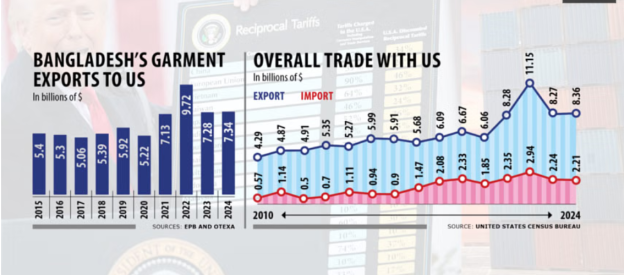The withdrawal of USAID was considered terrible by many, but aid flows are dwarfed by the export earnings that countries receive from trade. Bangladesh’s total trade with the US is worth around US$8.4 billion, compared to, at its peak, the US giving US$447 million in aid. The sudden imposition of these tariffs is likely to cause a much greater economic shock like the employment of up to 4 million in the Garment industry where the overwhelming majority are women. So clearly in a 21st century world of global interdependence, these tariffs will have serious repercussions for countries in the Global South like Bangladesh as the US takes a distinct shift towards aggressive protectionism.
Recent tariffs implemented by the U.S. administration have led to a complex trade situation for Bangladesh. While initial proposals had set very high tariff rates, Bangladesh successfully negotiated a lower, more favourable rate for its exports. This outcome is considered a significant diplomatic victory for Bangladesh.
Here is a summary of the impact:
-
Tariff Reduction and Competitiveness: The U.S. government initially proposed a tariff rate as high as 37% on Bangladeshi goods. After negotiations, a new tariff rate of 20% was secured.This lower rate is seen as a major win, as it puts Bangladesh on a more competitive footing with other key apparel-exporting countries like Vietnam and Sri Lanka, which also face similar rates. India, in contrast, faces a higher tariff rate of 25%, giving Bangladesh a clear advantage in the U.S. market, particularly in the vital apparel sector.
-
Impact on the Ready-Made Garment (RMG) Sector: The ready-made garments sector is the backbone of Bangladesh’s economy, and the U.S. is one of its largest export markets. The negotiated tariff rate is expected to help the sector retain its competitiveness and potentially increase its market share. This is especially true for core products like formal shirts, polo shirts, trousers, and sweaters, which make up a significant portion of Bangladesh’s apparel exports to the U.S.
-
Negotiation Strategy: The favourable outcome was a result of a multi-faceted negotiation strategy. This involved a combination of government-to-government talks and “backchannel” diplomacy by private-sector representatives, including garment exporters and commodity importers. A key element of the negotiation was Bangladesh’s commitment to purchase a substantial amount of U.S. goods, such as aircraft and wheat, to help balance the trade deficit.
Challenges and Outlook: While the lower tariff rate is a positive development, challenges remain. The overall tariff on some products will still be higher than before the new policies, and rising production costs in Bangladesh could offset some of the benefits. Exporters are also watching the trade policies of other competitor countries, like China, and their potential to recalibrate to regain competitiveness.
The Bond group of UK NGO’s suggestion in these circumstances
- Introduce a Business, Human Rights and Environment Act so that companies cannot get away with practices that drive human rights abuses and environmental destruction
- In light of the significant impact on garments exporters, it should introduce a Garment Trading Adjudicator to ensure UK companies treat suppliers fairly – just paying on time will be so important
- Finally, put workers and small producers at the heart of its forthcoming trade strategy.
Can we expect revolutions on the back of these profound changes in world trade? Let us just remind ourselves that the Americans had a revolution because they did not want to pay tariffs on tea to the British. So it will be interesting to see the response of ordinary Americans to increased inflation to their cost of living crisis.
